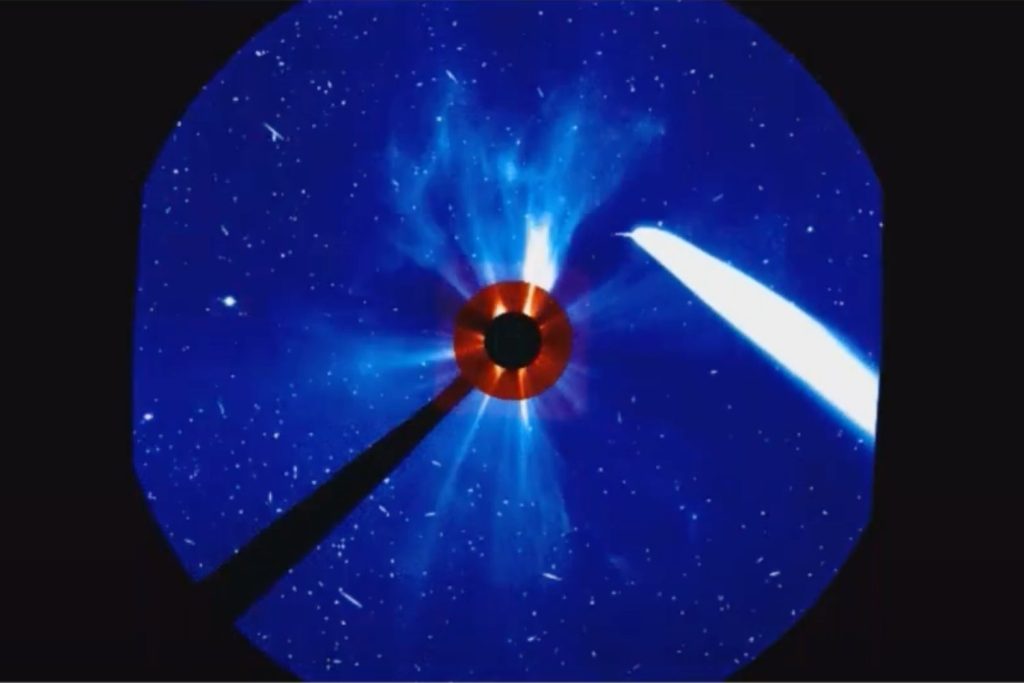
Incoming! Severe Solar Storm Could Disrupt Electronics and Spark Auroras Tonight (Image Credit: Gizmodo-com)
Earthlings, brace yourself: A severe (G4) geomagnetic storm will arrive on Earth imminently—between now and midday Eastern Time—which could make some electronics go haywire and generate beautiful auroras later today and tomorrow.
Geomagnetic storms are caused by charged particles from the Sun interacting with Earth’s magnetic fields. When severe, these events can disrupt electronic equipment such as those used for radio communications. But for those not using walkie-talkies, the storms are mainly known for the way they cause auroras: brilliant light shows in the atmosphere caused by the Sun’s charged particles interacting with those in our skies.
What is a geomagnetic storm, again?
I hope you’ll forgive me for quoting myself here, given the recency of the most recent geomagnetic storm. As we put it just last week, when the planet was under a storm watch:
A geomagnetic storm is a space weather phenomenon caused by explosions on the Sun’s surface. There are two different solar events that come into play here: solar flares and coronal mass ejections. As outlined by EarthSky, solar flares are brilliant flashes of light induced by magnetic activity on the Sun’s surface, like the criss-crossing of magnetic fields. Coronal mass ejections are eruptions of solar material that are ejected from the Sun, which can cause geomagnetic disturbances on Earth if the events are directed towards our planet. Those geomagnetic disturbances range from beautiful aurora in our planet’s skies to disruptions in the electrical grid and other human infrastructure.
Solar flares are ranked based on their intensity, from b-class to x-class—each letter class representing a tenfold increase in the flare’s intensity. The incoming geomagnetic event follows a coronal mass ejection (or CME) which itself follows an x-class solar flare on the Sun.
The image above shows the CME occurring on the Sun. Bright streak on the right of the image above is actually a comet rounding the Sun that has nothing to do with the geomagnetic storm. Space is a busy place!
What’s the deal with this storm?
The incoming geomagnetic storm comes from an X-class solar flare which left the Sun around 10 p.m. ET on Tuesday, October 8. The storm is supposed to arrive sometime between early morning and midday Thursday—in other words, as I write this.
The solar flare prompted a CME that is traveling towards Earth at about 2.5 million miles per hour (4 million kilometers per hour). Scientists won’t know the detailed structure of the CME until it is very close, about one million miles (1.61 million kilometers) from Earth. Once it is at that point—a region called L1—the CME will take between 15 to 30 minutes to reach Earth.
The National Oceanic and Atmospheric Administration’s Space Weather Prediction Center issued a severe (or G4) geomagnetic storm watch, making it the second G4 of the calendar year after a storm in May. The G4 event in May was the first G4 storm since January 2005 and caused auroras around the world, as far south as Florida in the northern hemisphere and also in parts of Australia and Africa in the southern hemisphere.
According to the storm watch, “detrimental impacts to some of our critical infrastructure technology are possible, but mitigation is possible.” The watch added that “the aurora may become visible over much of the northern half of the country, and maybe as far south as Alabama to northern California.” You can keep track of the aurora forecast on this Space Weather Prediction Center site.
In an alert published at 11:41 a.m. ET, the Space Weather Prediction Center stated there was an active warning of a G3 storm. That doesn’t necessarily mean we aren’t in for a G4 event, but that’s the latest data collected by the center. A G3 event would entail auroras “as low as Pennsylvania to Iowa to Oregon,” according to the alert. Just before noon ET, the Space Weather Prediction Center confirmed that the CME arrived on Earth and solar storm levels of G3 or greater are expected. Higher storm levels could push the visible auroras even farther south.
— NOAA Space Weather Prediction Center (@NWSSWPC) October 10, 2024
Why has the Sun been so active?
There has been a flurry of geomagnetic activity in recent months due to the Sun nearing the peak of its 11-year cycle, during which its magnetic field flips back and forth. This slipping causes sunspots, which beget the flares and CMEs on its surface.
The current solar cycle—Solar Cycle 25—began in 2020. There has been a recent increase in solar flares, CMEs, and geomagnetic storms as the Sun approaches its maximum.
To be frank, it’s a little difficult to keep the number of geomagnetic events straight. There was also an X-class solar flare last Tuesday (which is to say, a week before the solar flare kickstarting the upcoming geomagnetic storm). That solar flare prompted a flurry of auroras across the northern U.S. and other northerly reaches of our planet. But there were also severe geomagnetic storms in August and in May.
What did experts have to say?
“We are the midst of solar maximum right now,” said Shawn Dahl, a service coordinator for the Space Weather Prediction Center, in a press conference Wednesday. “We just don’t know if we’ve reached the peak yet.” Dahl added that if not now, the peak could be later this year or sometime through 2026.
The solar cycle has been more active than experts predicted, Dahl added, forcing researchers to recalibrate their predictions. Though we don’t know precisely when in the solar cycle we are, the activity will definitely begin to wane by 2026. For now, batten down your electrical hatches and keep an eye on the skies!





